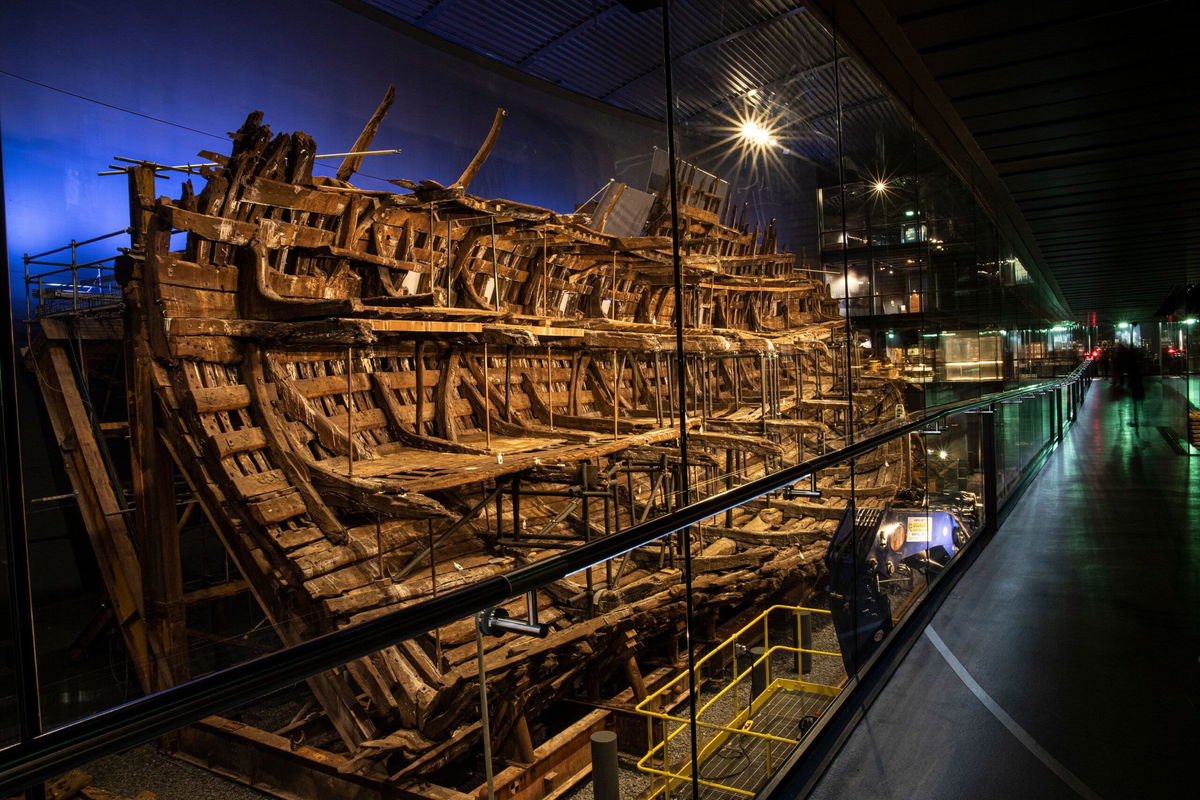Bones from a Tudor warship reveal what life was like for the crew

Excavators raise the hull of the 16th century English warship Mary Rose
By Ashley Strickland, CNN
(CNN) — The Mary Rose was a royal favorite when it first set sail as the flagship of King Henry VIII’s fleet in 1512.
Nearly 500 years after the vessel sank in 1545 during a battle with a French fleet, the shipwreck is revealing what life was like in Tudor England.
After the Mary Rose came to rest at the bottom of a strait in the English Channel, a layer of silt cloaked the ship and the hundreds of crew who died on board. The sediment preserved everything it covered. Underwater archaeologists carefully collected items and remains from the warship before raising the hull in 1982 and putting it on display in a museum in Portsmouth, England.
Now, researchers are studying the objects and bones from the wreck to better understand who the men were and how they lived.
Ocean secrets
Scientists now see how the tasks of life on a ship shaped the bone chemistry of 12 crew members from the Mary Rose by analyzing their collarbones. Collarbones capture information about age, development and growth as well as handedness, or which hand crew members favored.
The clavicles showed that all the men relied on their right hand, but they may have done so due to left-handedness being associated with witchcraft at the time, researchers said.
The findings of this new study are not only opening a window into the lives of the sailors but contributing to modern medical research by providing a better understanding of age-related changes in human bones.
Dig this
At first glance, the ancient fossil of a previously unknown arthropod uncovered in New York state looks like a glittering piece of jewelry. But the 450 million-year-old fossil of Lomankus edgecombei, which resembles a shrimp, is preserved in fool’s gold, or iron pyrite.
“Preservation in pyrite of this kind is extremely rare. In the last half a billion years there are only a handful of examples of places where this occurs,” said Luke Parry, associate professor of paleobiology at the University of Oxford.
Researchers were able to conduct CT scans of the fossil, which revealed insights into the arthropod’s adaptable head and appendages. The latter acted as a “biological Swiss army knife” enabling survival, Parry said.
Across the universe
The explosion of a star spotted in the night sky in 1181 was so bright that astronomers recorded it as a “guest star” in the Cassiopeia constellation.
Now, astronomers have used a new instrument to map the 3D structure of strange filaments radiating away from the “zombie star” created in the wake of the blast.
The bright filaments resemble the wispy structure of a dandelion, and studying their peculiar structure could help astronomers understand how the filaments formed in the first place.
Meanwhile, the “Halloween comet” disintegrated this week during its closest approach of the sun, and a solar mission captured footage of the comet’s final moments before it evaporated.
A long time ago
For years, mystery has swirled around the oldest known surviving tombstone in the United States, which is dated to 1627. The elaborate piece of black limestone, placed in the floor of a church in Jamestown, Virginia, has been called the “Knight’s Tombstone” because of carvings on its surface.
Now, an analysis of thumbnail-size microfossils in the stone has shed new light on the heavy slab, which came from Belgium and was shipped all the way to the first permanent British settlement in North America centuries ago.
The cost of shipping would have been astronomical, but the family of the high-status man to whom researchers believe the gravestone belongs likely had the funds to foot the bill.
Fantastic creatures
Experts at Tanzania-based nonprofit APOPO have recruited African giant pouched rats and their impressive noses to sniff out landmines, disease and survivors trapped beneath rubble after natural disasters.
Now, the nonprofit is also using the cat-size rodents to smell their way through the crafty disguises employed by wildlife traffickers looking to smuggle ivory, pangolin scales and rhino horns. Sometimes, traffickers stain ivory to look like wood or coat it in chocolate to make it through inspections.
But the trainable rats have an acute sense of smell. During a study, the rodents found 83% of the items and used their paws to pull on a little ball attached to custom vests to trigger a beeping sound, indicating they found something.
Discoveries
Catch up on these intriguing stories:
— Louisiana students Ne’Kiya Jackson and Calcea Johnson discovered a new way to prove the 2,000-year-old Pythagorean theorem using trigonometry, formerly thought impossible by experts.
— NASA has restored communications with the 47-year-old Voyager 1 probe after a glitch briefly led to a blackout. The aging spacecraft now is sending signals with a transmitter it hasn’t used since 1981.
— A light detection technique called LiDAR is helping archaeologists find thousands of previously unknown Maya structures in Mexico, including a large city named Valeriana.
— The Perseverance rover captured video of a “googly eye” shadow on Mars when its tiny moon Phobos passed between the red planet and the sun during a solar eclipse.
The-CNN-Wire
™ & © 2024 Cable News Network, Inc., a Warner Bros. Discovery Company. All rights reserved.